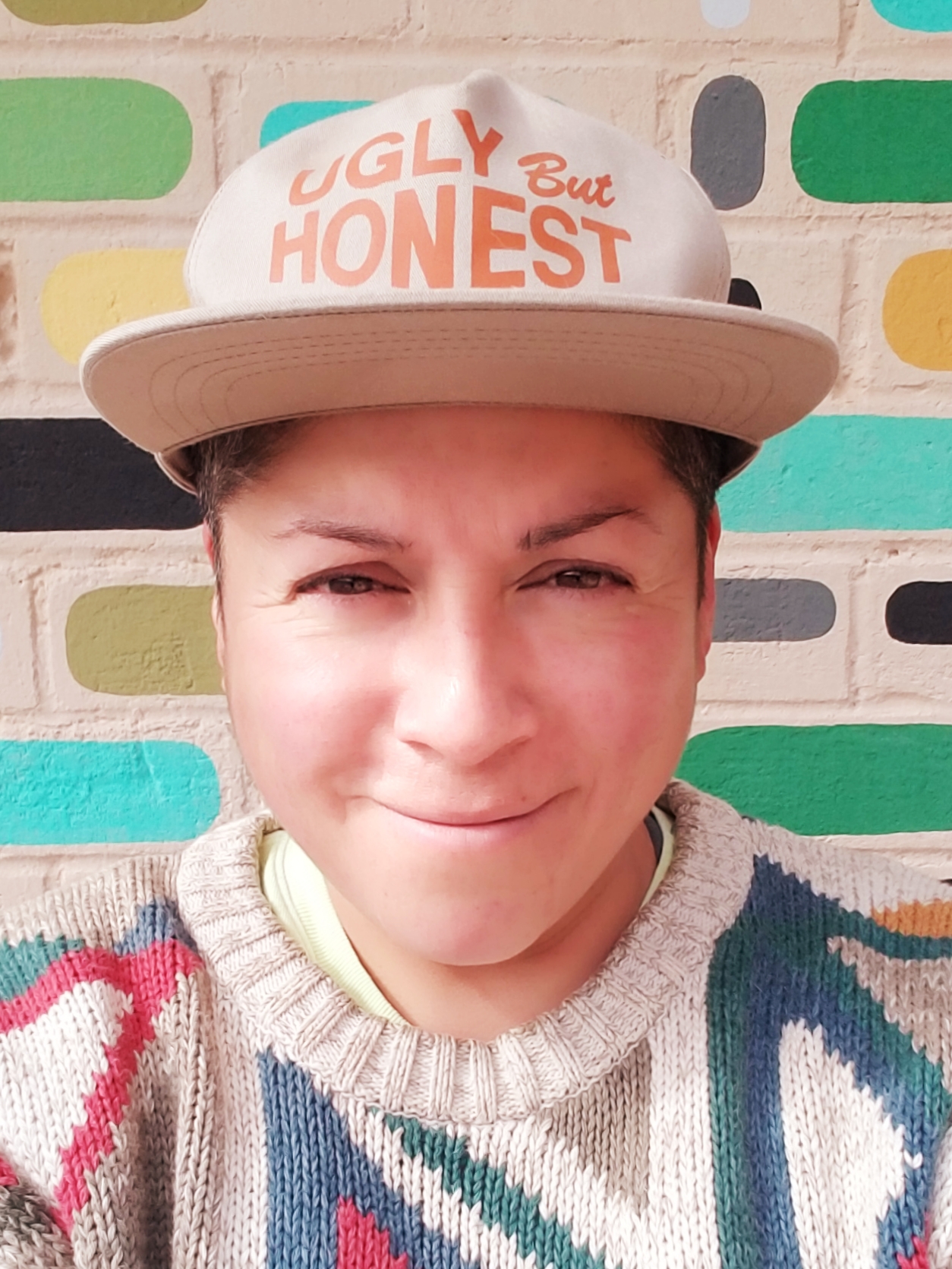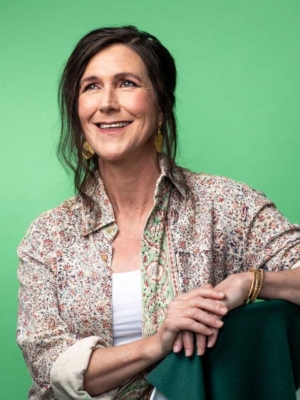Ghost Points and Hard Topographies: Facilitating Infrastructures — an interview with Raquel Gutiérrez
I was first introduced to the essays of Raquel Gutiérrez (she/they) by fellow-essayist Aisha Sabatini-Sloan in her “Collaging the Personal Essay” online seminar, hosted by Tin House in the spring of 2023. What drew me into Gutiérrez’s lean and layered prose was the sense that I was witnessing a writer who—like a dancer in a mosh pit—firmly situated herself within the swirl and violence of history, constructing narratives that created moments of recognition, culpability and stillness within a cacophonous circle. Gutiérrez’s first book and essay collection, Brown Neon (Coffee House Press), was named one of The Best Books of 2022 by The New Yorker and was a 2023 finalist for the Lambda Literary Prize for Best Lesbian Biography/Memoir, a 2023 finalist for the Community of Literary Magazines and Presses’ Firecracker Award in Creative Nonfiction, and recipient of The Publishing Triangle’s Judy Grahn Award for Lesbian Nonfiction.
In the Los Angeles Review of Books, Rachel León writes of Brown Neon, “There is no way to separate the political from the personal, no wall that could keep us from bleeding into one another. By blurring these lines, Gutiérrez invites us to consider how walls and borders are illusory, arbitrary, and restrictive. Freedom, alternatively, is something in motion.” The mosh pit, an organic system in motion, arises from the collective at a punk show. Gutiérrez, in Brown Neon, is particularly interested in exploring systems and infrastructures—border wall prototypes, interstate highways, artistic communities—that have impressed themselves onto a collective consciousness. Gutiérrez is committed to, in the words of León, inviting “the reader into an ongoing conversation with our past, present, and future. An essay can’t listen, but these come close, leaving room for questions left unanswered and realities left unlived.”
The stylistic and emotional choices Gutiérrez makes in their essays are what first drew me to her work. However, I found myself equally drawn to a few key biographical details we share: both raised in working-class communities in the Los Angeles basin, both coming of age within the SoCal punk scene, both queer and raised up within predominantly Black and Brown butch/femme communities, both children of immigrants (Gutiérrez is the daughter of a Salvadoran mother and a Mexican father; I am the daughter of an Iranian dad and a white American mom).
This summer, I was able to add another adjoining biographical detail to the list. I had the honor of being mentored by Gutiérrez, as a 2024 Lambda Literary Emerging LGBTQ+ Writing Retreat Fellow. Our nonfiction cohort was a generative space within which to workshop an essay exploring my claims to an Iranian-American diaspora through two conflicting pieces of architecture: a refinery in Los Angeles and an ancient capital seat in Iran. My own deep interest in systems and infrastructures was matched by the multi-genre craft talk Gutiérrez offered at the retreat entitled, “IN RUINS: Representing Infrastructure and Decay.” This interview was conducted over Zoom and edited for brevity and clarity.
There’s a strange, poignant. devastating mundanity that I think thinking about infrastructure enables us to get a little closer to. It’s a mundanity that unsettles people.
Mahru Elahi (ME): I’d love to start this conversation with some exploration of terms. I know that I often use words like system and infrastructure interchangeably. What is infrastructure to you and how do you apply these different definitions and concepts in your own work?
Raquel Gutiérrez (RG): I think about infrastructure in terms of systems. I like to think of the types of spaces and publics that I’ve occupied at various points in my life: as a queer person of color, as a queer Latinx, queer Chicana, queer Latino/a child of immigrants, and all the ways that (these spaces and publics) facilitate cross-class, cross-group contact. I did grow up with the sense that you have the private sphere: you have the home, you have those who are raising you. I think about how systems of power are already contouring and structuring those interpersonal relationships. Outside of the home, institutions like libraries and hospitals provide these important services to our knowledge production and resource gathering. That doesn’t happen in a vacuum. We take for granted the ways that these entities facilitate our ability to be in the world, and the opportunities that we can seize upon as both individuals and groups, to just improve our situation.
When you’re a writer, you’re constantly thinking about the next site of inquiry. What puts me in contact with people from other generations who are experiencing the world on different terms, with different technologies and innovations? How do these technological evolutions produce the types of interactions and connections we have with our families, with our neighbors, with our friends, colleagues, and the people that we have to tolerate because we live on the same block and that’s just the way that the dice was rolled? There’s a strange, poignant. devastating mundanity that I think thinking about infrastructure enables us to get a little closer to. It’s a mundanity that unsettles people.
ME: When did you begin to think about your work this way? I’ve heard you mention that you started thinking about infrastructure very intentionally after the making of your essay collection Brown Neon. Yet Brown Neon contains so much infrastructure. Talk more about what you observed once Brown Neon was out in the world. What moments of realization brought you to your current understanding about how infrastructure is mediated in your work?
RG: I think the light bulbs went on when I was on Interstate 10, driving through the desert from Los Angeles to, say, San Antonio or Austin. It was the most easterly that I had traveled on the 10, that big interstate highway that connects so many states and cities. It’s not quite on the same trajectory as the border, but it’s the closest interstate. On one side of the border you have Texas and New Mexico, Arizona and California. There are all sorts of touch points with Mexico. Then you have Louisiana and Alabama, Georgia and Florida in proximity to the border. They’re the ghost points of the border: the way that land and dispossession and territorialization, all of those conditions just animate and inform the way we get around. Interstate infrastructure makes it possible for us to go to these places, these hard topographies. The physical geography of these places in the desert are no joke. You need physical intervention to extract all of the resources that these lands have to offer, like copper and oil and agriculture.
They’re the ghost points of the border: the way that land and dispossession and territorialization, all of those conditions just animate and inform the way we get around. Interstate infrastructure makes it possible for us to go to these places, these hard topographies.
When I was a kid, my mom stayed at home. She was a nurse in El Salvador, but in the US, because of accreditation, she could only be a certified nurse’s assistant, and then eventually a licensed vocational nurse. She would take us to a little toy section in this auto shop called Western Auto where she would buy us kick balls and yo-yos. And there was this board game about learning what resources each state was exporting. There were these icons on the board. California had a film strip for Hollywood, and oranges, and a plane for the aerospace industry. Arizona was copper and Idaho was potatoes. Steel was from Pennsylvania. I was so fascinated by that. It was a very interesting pre-NAFTA way of teaching kids about industrial production. This is what each state is good for. You grow up in the eighties thinking like, “Oh, this country is rich!!” That board game did imprint on me. A state is only able to thrive because its industries employ people, where people can buy homes without having to go to college. That sets you up for a lot of expectation in the sense that you’re going to have that, too, when you’re growing up. It’s like, “Well, I don’t know if it’s going to be oranges; maybe I’ll make movies. I live in California. This game says what my state is good for. So cool. I’m excited.” It helped me imagine. There’s a whole system already set up, and we just plug into it.
ME: I’m imagining your writer self as a child. It sounds like you were starting to tell stories of yourself and your family within this bigger system at an early age.
RG: (Western Auto) was a weird little store run by some people, and it was next to a Newberry’s or Woolworth’s. It wasn’t a big box store. Around the corner was a Mexican restaurant, and then a discount movie theater where I saw a double feature of Amadeus and some movie about a dinosaur. We went to see The Color Purple there, and my mom covered my eyes. This discount theater was across from the public library, and next door they made fruit hand pies. The whole block smelled like sugar. It was amazing; every kid was begging their parent to be taken there after school. The world was set up.
If you’re a kid and you’re reading Richard Scarry, you know this is how society runs. There’s a school, and there’s someone who rides a school bus, and there’s a cat and he’s a cop, and there’s a lowly worm and he’s anxious because he’s not sure if he’s cut out for this rat race. Richard Scarry was like the gateway drug: alright kids, have your fun. But get ready, because we also need your young body to extract labor from, and hope that you don’t feel too bad about it.
ME: These spaces are truly mapped onto us. They’re mapped onto our memory and our bodies.
RG: Totally. And artists are made fun of. They’re not given the same consideration, critical weight, respect. We need artists in society. I’ve always been concerned with the ways that people connect to one another. There are multiple ways of connection that go beyond the transactional. From a young age, I belonged to a creative community and saw all the intergenerational dynamics that made it possible for various creative systems in Los Angeles to do well, to thrive and grow and inspire new generations to come in and take their positions in these critical social infrastructures.
ME: How can we mediate infrastructure through writing and art?
RG: All I can offer is: write a story where infrastructure is represented by an image or as a space of convergence. I think of your essay about the Wilmington Refinery (located alongside the 405 freeway near San Pedro, CA). It’s like, “Wow, who made that?” It is a powerful thing that you notice more at night: the refinery lights sort of dance and there’s this dramatic quality. During the daytime, you’re stuck in traffic and it’s a chaotic feeling, “I don’t like it here. I’m stuck.” I’m wanting to know: what is the story of this place? It seems to have fucked over the people that live here. But also, how is this writer tethering the figure of the Wilmington refinery to (the Iranian architectural treasure) Persepolis? That is a powerful sort of diasporic claim. It’s beautiful. There’s so much here to intrigue me as a reader, especially because an Angeleno identity is so contingent on your relationship to the freeway.
ME: I keep coming back to the beautiful sites of memory you evoked earlier: the automotive supply shop with all the kid’s stuff that was across from the hand pie factory and the Newberry’s. I’m thinking about how we map memory and my own writing of growing up Iranian American around Los Angeles’ petroleum infrastructure. This conversation is reminding me that I still live in a place that’s mediated by petroleum. I’m in the Bay Area and there are refineries all over. In fact, Richmond, CA reminds me a lot of where I grew up in Los Angeles. But here, they paint the holding tanks a beautiful brick color, like an earth red. And the holding tanks sit in this very Golden State hilly landscape. Someone clearly did color consultation for the holding tanks. I happened to be driving with a colleague; she pointed towards the tanks and stated that she knows the person who chose that color.
RG: I think that’s a thing, because when the border wall prototypes were being considered, color and aesthetics was very much part of the criteria. When you have architectures that are fascist or hostile, that organizes our whole society. When it’s working against us, we don’t like it. Why would you put rails on this bench to keep unhoused people from sleeping? Or: coming home from our summer travels and exiting off the 10, we saw a bunch of boulders below the underpass, deposited to prevent people from sleeping there. I’m just like, “Come on, y’all.” I did not want my tax money to…who’s the dude that pulls the boulder up the hill?
ME: Sisyphus.
RG: This I don’t want. I don’t want to pay for infrastructure if it’s just cosplay.
ME: I’m interested in the systems and infrastructure that are currently fascinating you and pulling you down a rabbit hole. What are you exploring?
RG: What’s eating away at me is Central American histories of solidarity: the eighties, late seventies, and early nineties, the US interventions in El Salvador and Guatemala. All the CIA stuff, the Guatemalan Genocide (of Mayan people) and the Salvadoran Civil War. How did these histories get lost to the generations after me? I was a very young person learning about all these things that were impacting Central American immigrants. They were very much part of the downtown Los Angeles social fabric. Policy, underground organizing and agitating: all of that stuff is lost to people who are in their twenties now. What gets my craw is: how do people not know this? Your only sense of El Salvador is (Nayib) Bukele? The Bukele regime is anti-queer and anti-trans. He’s trying to destroy any evidence of the leftist guerrilla FMLN (Farabundo Martí National Liberation Front). And trying to whitewash that history.
How do we maintain our links in the chain of history and knowledge production? The archive is a way to think about my own family’s conservatism and their own (I don’t even know if this is ableist to say) social and political myopias. I have been thinking about this through art and my own memories of Los Angeles, the Democratic National Convention of 2000, the 2001 earthquake in El Salvador and how that shaped US immigration policy. I’m interested in the infrastructural qualities to these inquiries. There are many flavors of infrastructure, particularly social infrastructure within Salvadoran enclaves in Los Angeles. It made it possible for people to have deep networks.
ME: How do we maintain the links in the chain of history and knowledge production? How are you approaching this question in your writing?
RG: I always tell folks: just pretend you’re at the funnest, coolest dinner party, or at an art opening. Music is playing. The mezcal, or the mocktails, are just lit. Tell the story of the thing versus over-explaining.
During my MFA, I had good friends and workshop colleagues who were struggling with this idea of writing from a place of fragmentation. That brings me to one of my first Central American Studies professors, Beatriz Córtez. She left El Salvador at 18 and got her PhD. Fifteen years later, she gets an MFA and is now an art school professor. She’s coming from a place of simultaneity. That just lights her up. It’s the motherboard, in terms of her output. She’s been in the US for a lot longer than she was in El Salvador. But for her it’s still a simultaneous project, or a project of simultaneity. I feel like that’s an important pivot to make, for those of us who are in whatever diasporic configuration we’re born into.
ME: Simultaneity also makes me think about the ways that we use the speculative in nonfiction.
RG: Yeah, I think the speculative impulse is especially for queer writers of color or writers who are emerging from a nondominant paradigm of power. The speculative allows us to get closer to whatever features that we’re interested in enacting. José Muñoz says queerness is not here yet. Queerness is on the horizon, glimpses of possibility. Or potentiality. I think that’s very much it. That’s been in the ether for the last decade. I think it animates a lot of writing and thinking. I feel like there are moments where people are dropping into the speculative, because we’re not rehearsing that which has already fucked us over. We’re not rehearsing the way that we’ve been dispossessed. We’re all trying to write ourselves, or we’re trying to inhabit the space of the speculative gesture.
I feel like there are moments where people are dropping into the speculative, because we’re not rehearsing that which has already fucked us over. We’re not rehearsing the way that we’ve been dispossessed. We’re all trying to write ourselves, or we’re trying to inhabit the space of the speculative gesture.
ME: How do you see yourself imagining in ways that feel speculative?
RG: I think what I’m speculating about is the relationship to authority and the relationship to power. There are people in my family who willfully want power, or willfully surrender to power. But also they have been shaken up by immigration, shaken up by the disempowerment, the dispossession and dehumanization. Of course, they’re going to be conservative: any chance they can have to fuck over someone more vulnerable than them, they will. I think that’s the thing that I’m having to grapple with or think about. What is authority? What is power? How has that rotted our spirits?
ME: We’ve talked a lot about the liberatory potential of queering systems in this conversation. If you could control or guide the development of some form of infrastructure after the revolution, which would you choose and why?
RG: Energy! Telecommunications! Water! All that. Well, actually, telecommunications. You want to control the means of your narrative delivery. Not to be super dictatorial, but I really need this revolution to work.
ME: This makes me think of an undergraduate lecture that Donna Haraway gave at UC Santa Cruz, way before the World Wide Web, where she made the entire class promise that—when the revolution came—we would give her total control over Reader’s Digest. Her reasoning: since it was the most distributed text in the world and translated amongst hundreds of different languages, she would have the power of culture and voice at her fingertips; this was her infrastructure for the new millennium. She gave this example as a door into a class discussion about alternative institutions.
RG: Reader’s Digest! That was the shit. I don’t know how we got that delivered to our house when I was growing up, but I was just like, “Oh, my God. This is amazing. And this is exactly the right length.”
Known for her big laugh, Mahru Elahi (she/her/they/او) is a queer Iranian American femme. Her writing sprouts from a desire to love on herself and her SWANA—Southwest Asian North African—community. She has received support from Lambda Literary Emerging LGBTQ+ Writers Retreat, Tin House online seminars, Hedgebrook, VONA, Antioch University Los Angeles, and the UCLA Extension Writers’ Program. Their poetry and nonfiction prose appear in Fireweed, the museum of americana, MUTHA, Hyphen, Let Me Tell You Where I’ve Been: New Writing by Women of the Iranian Diaspora, and Days I Moved Through Ordinary Sounds: The Teachers of WritersCorps in Poetry and Prose. A former high school English teacher and the Managing Editor of Content and Production for Lunch Ticket, a literary and art journal from the MFA community at Antioch University Los Angeles, Mahru lives in Oakland with their son.






